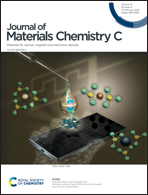Modifying polymer PM6 by incorporating a third component for an enhanced short-circuit current density†
Abstract
At present, the polymer PM6 is the most widely used donor polymer, with many researchers focusing on improving the performance of PM6. The most commonly used strategy for modifying the polymer PM6 is to form a ternary random copolymer by incorporating a third component. However, most reported modified PM6 terpolymers have strictly equal D and A units. Herein, we developed four novel D–A–D–D1-type copolymer donors (PM6-T5, PM6-T10, PM6-T15 and PM6-T20 with a D1 unit with molar ratios of 5%, 10%, 15% and 20%, respectively) by introducing a third component (BDT-T: 2,6-dibromo-4,8-bis(5-(2-ethylhexyl)thiophen-2-yl)benzo[1,2-b:4,5-b′]dithiophene) into the backbone of PM6 with unequal D and A units (D/A unit ratio > 1). Compared with the alternate D–A copolymer PM6, the four D–A–D–D1-type copolymers possess an up-shifted lowest unoccupied molecular orbital (LUMO), a down-shifted highest occupied molecular orbital (HOMO), and a higher degree of self-assembly. As a result, owing to the suitable energy level, crystallinity, better absorption, higher hole mobility and prolonged exciton life, the PM6-T15:Y6-based OSCs achieved a high power conversion efficiency (PCE) of 16.61% with a remarkably enhanced short-circuit current density (JSC) of 27.02 mA cm−2 and a higher fill factor (FF), which performed better than the reference PM6:Y6-based organic solar cells OSCs (PCE:14.51%).



 Please wait while we load your content...
Please wait while we load your content...